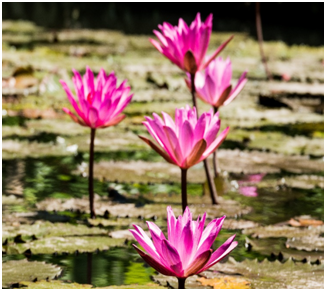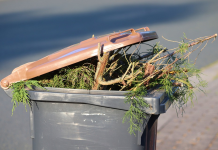 Adding Plants to Your PondPlants is a key feature of a healthy wildlife pond. They can help keep the pond ecologically balanced by shading the water, removing excess nutrients, and providing food for your fish. A mixture of plants, pond fountains, aerators, and beneficial bacteria can all play a role in getting you the healthiest pond environment.
Adding Plants to Your PondPlants is a key feature of a healthy wildlife pond. They can help keep the pond ecologically balanced by shading the water, removing excess nutrients, and providing food for your fish. A mixture of plants, pond fountains, aerators, and beneficial bacteria can all play a role in getting you the healthiest pond environment.
There are four basic types of plants that you can add to your pond and the surrounding edges: deep water, floating, submerged, and marginal plants. Although ideally, you want to include a variety of each type, some plants have a certain depth, sunlight, and temperature requirements and may not be feasible for your pond.
Most vendors of aquatic plants sell a wide variety of native and non-native species, but it is a good idea to choose primarily native aquatic plants. To help you decide which plants to add to your pond, a good plant guide is needed for determining sunlight and depth requirements, if the plant is native or exotic, and within which zones each plant is hardy.
Table of Contents
Deep-water Plants
The leaves of deep-water plants usually float on the water’s surface, but their roots grow in the soil (or pots). Water lilies are especially popular among pond builders, and there are many varieties. However, many tropical or subtropical species need long hours of direct sunlight and warm temperatures every day to bloom. Also, both hardy and tropical species require protection in the winter (hardy species can remain in the pond as long as their roots do not freeze).
A combination of these deep water and free-floating plants (see below) should not cover more than 70 percent of the pond’s surface. This helps provide a balanced amount of sunlight for shading the water (helping to reduce algae levels) but allows enough sunlight for submergent plants growing below the water. Although it is preferred to buy deep water plants directly in their containers, finding local suppliers of these plants may be hard. Mail-order companies sell bare-root plants that you can later be put into pots.
Free-Floating Planets
The leaves of free-floating plants float on the surface, but the roots are not anchored to the soil. Free-floating plants include many species such as frog’s bit and small duckweed. These and deep-water plants both shade and remove nutrients from the water, helping to decrease potential algae outbreaks. Although many species of floating plants, such as water lettuce and water hyacinth, are considered invasive in southern climates, they are not hardy in the north and will die during the winter months (unless they are brought inside). However, experts recommend avoiding potentially invasive species for your pond. Plants that are hardy in northern climates will fall to the bottom of a pond during the winter and reemerge in the spring. Northern-hardy plants can grow rapidly and may need to be thinned out periodically during the summer to prevent them from overtaking the pond, so you should keep this in mind.
Oxygenators or Submergents
These types of plants grow completely or primarily underwater, releasing oxygen and filtering out excess nutrients. It is recommended to add at least one bunch of submergence for every one to two square feet of water. Many of the plants found in this group can grow quickly and can potentially overtake a pond if they are not thinned out regularly. The many native species include Illinois pondweed, Eastern purple bladderwort, hornwort, common watermilfoil, and broad waterweed. You should avoid exotic and invasive species like hydrilla, Eurasian watermilfoil, and parrot feather.
Marginal or Bog Plants
The roots of marginal plants are submerged or partially submerged in the water; marginals include cattails and other grasses, rushes, and sedges. These plants are often grown in containers and placed on shelves within the pond or are planted around its edges. Many types of emergent plants, such as spotted joe-Pye weed, sweet flag, soft rush, and pickerelweed, are incredibly attractive to either butterflies or dragonflies.
However, do not plant purple loosestrife. This plant has attractive purple flowers, but it is extremely invasive.
There is no limit to the number of plants you can add to the surrounding areas of your pond. Many species will attract butterflies and other insects, as well as birds. Adding a diverse array of plants and grasses with logs and rocks can provide food and cover for both aquatic and terrestrial species around and in your pond. Some beneficial native flower species that you can plant around your pond include Joe-Pye weed, cardinal flower, turtlehead, bee-balm, and black-eyed Susan. Common shrubs include black chokeberry, buttonbush, winterberry, and spicebush.
Pieces to A Healthy Pond
Knowing which plants could potentially benefit your pond is important. Pond plants come in a variety of forms, floating or deep-water, and have various applications. Plants, pond fountains, aerators, and beneficial bacteria are all pieces of the healthy pond puzzle. Who doesn’t want a clear, clean pond?















